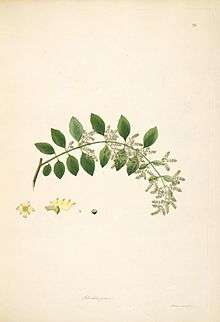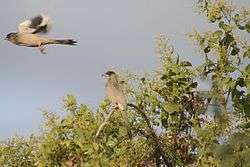Salvadora persica
| Salvadora persica | |
|---|---|
 | |
| Scientific classification | |
| Kingdom: | Plantae |
| Clade: | Angiosperms |
| Clade: | Eudicots |
| Clade: | Rosids |
| Order: | Brassicales |
| Family: | Salvadoraceae |
| Genus: | Salvadora |
| Species: | S. persica |
| Binomial name | |
| Salvadora persica | |
.jpg)

Salvadora persica (arak, Galenia asiatica, meswak, peelu, pīlu, Salvadora indica, or toothbrush tree, mustard tree, mustard bush), is a species of Salvadora.[1] Salvadora persica has antiurolithiatic properties.[2] Used for centuries as a natural toothbrush, its fibrous branches have been mentioned by the World Health Organization for oral hygiene use.[3]
Description
Salvadora persica is a small tree or shrub with a crooked trunk, seldom more than one foot in diameter. Its bark is scabrous and cracked, whitish with pendulous extremities. The root bark of the tree is similar to sand, and the inner surfaces are an even lighter shade of brown. It has a pleasant fragrance, of cress or mustard, as well as a warm and pungent taste. The leaves break with a fine crisp crackle when trodden on. The tree grows to a maximum height of three meters.[4]
Distribution
The plant is native to the Middle East and Africa.[5]
History and use
Salvadora persica is a popular teeth cleaning stick throughout the Arabian Peninsula, as well as the wider Muslim world.[6] The fresh leaves can be eaten as part of a salad and are used in traditional medicine.[4] The flowers are small and fragrant and are used as a stimulant and are mildly purgative.[4] The berries are small and barely noticeable; they are eaten both fresh and dried.[4] The wood of the Salvadora persica can be used for charcoal and firewood.[7] In Namibia, the mustard bush is used as drought-resistant fodder for cattle. The seeds can be used to extract a detergent oil.[5]
As of 2009, Botanic Gardens Conservation International has a total of eight Salvadora persica plants in conservation.[8]
See also
References
- ↑ "Salvadora persica". Food and Agriculture Organization of the United Nations. Retrieved 2009-02-16.
- ↑ Geetha K, Manavalan R, Venkappayya D.,"Control of urinary risk factors of stone formation by Salvadora persica in experimental hyperoxaluria." Exp Clin Pharmacol. 2010 Nov;32(9):623-9
- ↑ "Prevention Methods and Programmes for Oral Health. Report of a WHO Expert Committee Technical Report Series 713" (PDF). World Health Organisation. 1987. Retrieved 1 March 2018.
- 1 2 3 4 Sadhan RI, Almas K (1999). "Miswak (chewing Stick): A Cultural And Scientific Heritage". Saudi Dental Journal. 11 (2): 80–88.
- 1 2 Rothauge, Axel (25 February 2014). "Staying afloat during a drought". The Namibian.
- ↑ National Institute of Industrial Research (2003). Herbs Cultivation & Their Utilization. Delhi: Asia Pacific Business Press. pp. chapter 2. ISBN 978-81-7833-064-8.
- ↑ Aumeeruddy MZ, Zengin G, Mahomoodally MF (March 2018). "A review of the traditional and modern uses of Salvadora persica L. (Miswak): Toothbrush tree of Prophet Muhammad". Journal of Ethnopharmacology. 213: 409–444. doi:10.1016/j.jep.2017.11.030. PMID 29196134.
- ↑ "Botanic Gardens Conservation International - PlantSearch database|".
External links
| Wikimedia Commons has media related to Salvadora persica. |